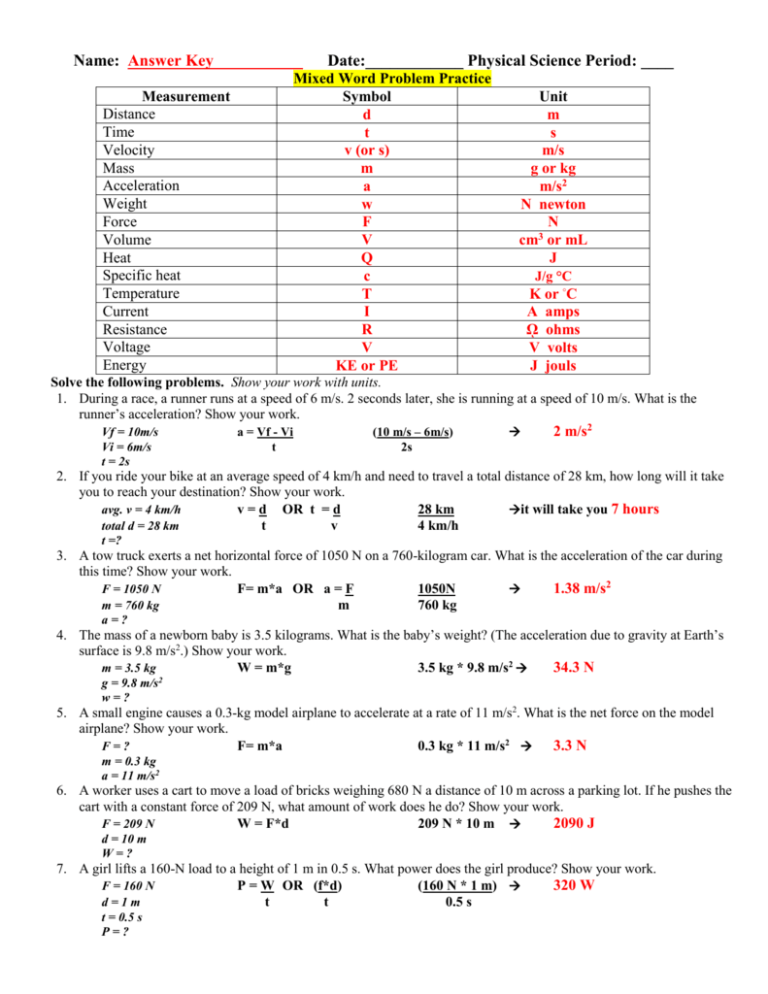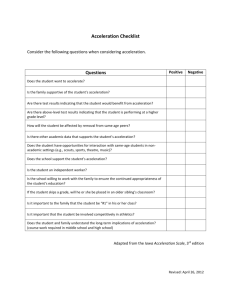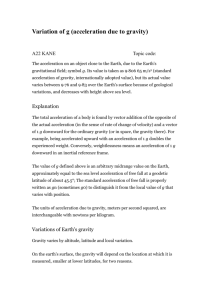Name: Answer Key Date:______ Physical Science Period
advertisement

Name: Answer Key Date:____________ Physical Science Period: ____ Mixed Word Problem Practice Symbol d t v (or s) m a w F V Q c T I R V KE or PE Measurement Distance Time Velocity Mass Acceleration Weight Force Volume Heat Specific heat Temperature Current Resistance Voltage Energy Unit m s m/s g or kg m/s2 N newton N cm3 or mL J J/g °C K or ◦C A amps ῼ ohms V volts J jouls Solve the following problems. Show your work with units. 1. During a race, a runner runs at a speed of 6 m/s. 2 seconds later, she is running at a speed of 10 m/s. What is the runner’s acceleration? Show your work. Vf = 10m/s Vi = 6m/s t = 2s a = Vf - Vi t (10 m/s – 6m/s) 2s 2 m/s2 2. If you ride your bike at an average speed of 4 km/h and need to travel a total distance of 28 km, how long will it take you to reach your destination? Show your work. avg. v = 4 km/h v = d OR t = d 28 km it will take you 7 hours total d = 28 km t v 4 km/h t =? 3. A tow truck exerts a net horizontal force of 1050 N on a 760-kilogram car. What is the acceleration of the car during this time? Show your work. F = 1050 N F= m*a OR a = F 1050N 1.38 m/s2 m = 760 kg m 760 kg a=? 4. The mass of a newborn baby is 3.5 kilograms. What is the baby’s weight? (The acceleration due to gravity at Earth’s surface is 9.8 m/s2.) Show your work. m = 3.5 kg W = m*g 3.5 kg * 9.8 m/s2 34.3 N g = 9.8 m/s2 w=? 5. A small engine causes a 0.3-kg model airplane to accelerate at a rate of 11 m/s2. What is the net force on the model airplane? Show your work. F=? F= m*a 0.3 kg * 11 m/s2 3.3 N m = 0.3 kg a = 11 m/s2 6. A worker uses a cart to move a load of bricks weighing 680 N a distance of 10 m across a parking lot. If he pushes the cart with a constant force of 209 N, what amount of work does he do? Show your work. F = 209 N W = F*d 209 N * 10 m 2090 J d = 10 m W=? 7. A girl lifts a 160-N load to a height of 1 m in 0.5 s. What power does the girl produce? Show your work. F = 160 N P = W OR (f*d) (160 N * 1 m) 320 W d=1m t t 0.5 s t = 0.5 s P=? 8. The input force of a pulley system must move 8.0 m to lift a 3000-N engine a distance of 2.0 m. What is the IMA of the system? Show your work. IMA = ? MA = De 8.0 m 4 De = 8.0 m Dr 2.0 m Dr = 2.0 m 9. A 20-N force applied to the handle of a door produces a 44-N output force. What is the AMA of the handle? Show your work. Fr = 44 N MA = Fr 44 N 2.2 Fe = 20 N Fe 20 N MA = ? 10. What is the kinetic energy of a 72.0-kg sky diver falling at a terminal velocity of 79.0 m/s? Show your work. KE = ? KE = ½*m*v2 (½ )(72.0 kg)(79.0 m/s)2 m = 72.0 kg = (36) * (6241) 224, 676 J v = 79.0 m/s 11. A 0.47-kg squirrel jumps from a tree branch that is 3.5 m high to the top of a bird feeder that is 1.2 m high. What is the change in gravitational potential energy of the squirrel? (The acceleration due to gravity is 9.8 m/s 2.) Show your work. GPE = ? GPE = mgh (0.47 kg)(9.8 m/s2)(2.3 m) 10.59 J m = 0.47 kg g = 9.8 m/s2 h = 3.5 m – 1.2 m = 2.3 m 12. A small dog is trained to jump straight up a distance of 1.2 m. How much gravitational potential energy does the 7.2 kg dog need to jump this high? (The acceleration due to gravity is 9.8 m/s2.) Show your work. GPE = ? GPE = mgh (7.2 kg)( 9.8 m/s2)(1.2 m) 84.67 J m = 7.2 kg g = 9.8 m/s2 h = 1.2 m 13. How many kilojoules of heat must be transferred to a 480-g aluminum pizza pan to raise its temperature from 22°C to 234°C? The specific heat of aluminum in this temperature range is 0.96 J/g·°C. Show your work. Q=? Q = mc∆T (480 g)( 0.96 J/g·°C)(212 °C) 97689.6 J m = 480 g c = 0.96 J/g·°C ∆T = 234°C - 22°C = 212 °C 14. As 390 g of hot milk cools in a mug, it transfers 30,000 J of heat to the environment. What is the temperature change of the milk? The specific heat of milk is 3.9 J/g°C. Show your work. Q = 30,000 J ∆T = Q 30,000 J 30,000J 19.72 °C m = 390 g mc (390g)(3.9 J/g °C) 1521 J/°C c = 3.9 J/g·°C ∆T = ? 15. What is the acceleration of a car that goes from 20 km/h to 100 km/h in 2 hours? a=? a = Vf – Vi 100 km/h – 20 km/h Vf = 100 km/h t 2 hrs 40 km/h Vi = 20 km/h t = 2 hrs 16. An object moves 20 km in 5 h, what is its speed? v=? v=d d = 20 km t 20 km 5 hr 4 km/hr t = 5 hr 17. If the force on an object is 14 N and the object has a mass of 3.5 kg what is its acceleration? F = 14 N F = m*a OR a = F 14N 4 m/s2 m = 3.5 kg m 3.5kg a=?








